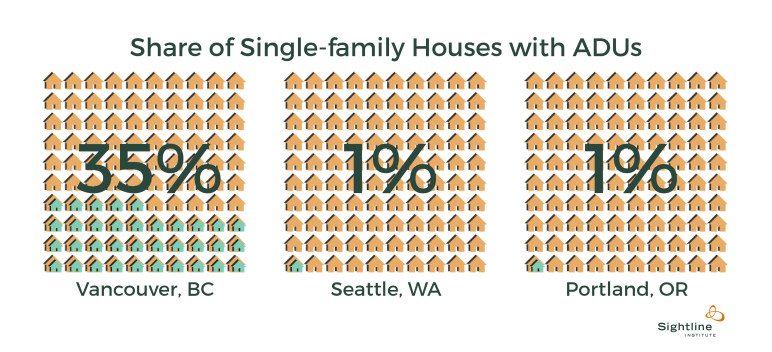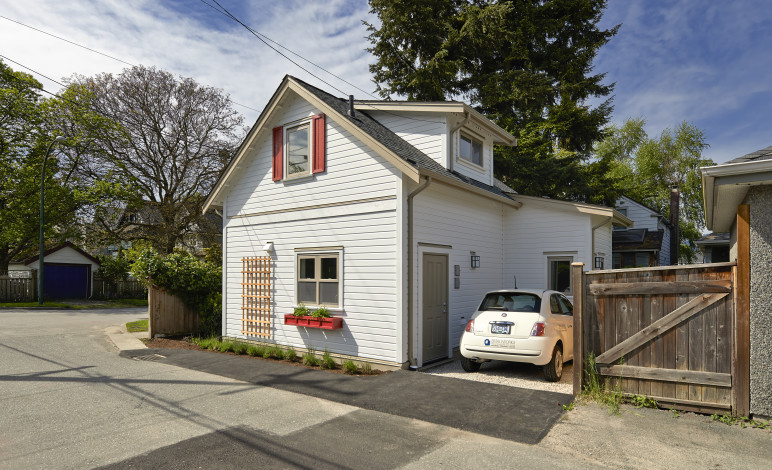Editor’s note: This article is Sightline’s very first from our new senior researcher, Dan Bertolet. We’re thrilled to have him on board to help both continue and expand our work pursuing smart solutions to our region’s big questions on housing and urban growth. Read his full bio here, and follow him on Twitter at @danbertolet.
Cascadia’s three largest cities have all sworn themselves devotees of the accessory dwelling unit (ADU)—also known as the in-law apartment or backyard cottage. But only one of the three has actually built any more than a smattering of them. In Vancouver, BC, fully one-third of single-family houses have legal ADUs; in Portland and Seattle, scarcely one percent of houses sport a permitted secondary dwelling. This yawning gap reveals a big opportunity for addressing future housing needs in growing cities.

The current state of Cascadia’s ADUs
ADUs are relatively modest apartments or cottages integrated into single-family properties, and they come in two flavors: physically attached to the main house (AADU), or detached in a structure separate from the single-family house on the same lot (DADU). Most fall in the moderate affordability range—$1,200 to $1,800 per month for a one-bedroom unit in Seattle—and offer a housing option in single-family neighborhoods for residents who cannot afford a single-family house.
Known as “granny flats” for a reason, ADUs work well for multigenerational families. And they are particularly well-suited for young children, because they tend to be relatively large (at least for a rental), provide direct access to outdoor yards, and are often located in neighborhoods well served with schools and parks.
The table below shows the current ADU and single-family home stats for Vancouver, Seattle, and Portland. Vancouver has a staggering lead in AADUs, with more than 21 times as many in-law apartments (called “secondary suites” in Canada) as Seattle and almost 44 times as many as Portland. The city also holds an ample lead in DADUs (“laneway houses,” in Vancouver’s parlance).
|
Vancouver |
Seattle |
Portland |
|
| AADUs |
25,300 |
1,184 |
580 |
| DADUs |
1,350 |
212 |
720 |
| Single-family Houses |
75,000 |
134,000 |
153,000 |
What’s holding back Cascadia’s ADUs
Myriad regulatory barriers currently litter the law books of Cascadian cities, clogging the ADU pipeline. Vancouver’s success in building more than 26,000 ADUs has been all about undoing those restrictions. Starting in the late 1980s, the city legalized thousands of existing, but illegal, ADUs. Over time, it eliminated the most counterproductive barriers. Vancouver, unlike many Cascadian cities:
- does not require an off-street parking spot for each ADU,
- does not require the owner to live on site,
- allows single-family lots to host both an AADU and a DADU,
- awards additional occupancy limits for each dwelling on a property, and
- provides great latitude to property owners in terms of size, height, and placement of each ADU.
Vancouver demonstrates a substantial housing opportunity for other cities. Matching Vancouver’s ADU track record would mean 47,000 ADUs in Seattle and 54,000 ADUs in Portland. Unfortunately, recent rates of construction in these cities would not yield that much for several hundred years. To seize the ADU opportunity and match Vancouver, Portland and Seattle will also have to match Vancouver’s welcoming set of ordinances.

Seattle is poised for progress on ADU code improvements intended to unleash production through the recently introduced Housing Affordability and Livability Agenda (HALA). HALA calls for more ADUs and prescribes most of the regulatory improvements listed above. HALA also recommends establishing a “clemency program” to legalize undocumented ADUs, which amount to perhaps two or three times the permitted inventory. (The City of Seattle makes no attempt to count unpermitted ADUs).
Next to Vancouver, Portland is the most ADU-friendly city in Cascadia, mainly because the Rose City requires neither parking nor owner occupancy for ADUs. However, Portland only allows one ADU per property, imposes a low site occupancy limit (no more than 6 unrelated people), and requires 2-story DADUs to match the design of the main house. Compared to Seattle, in recent years Portland’s rate of DADU production has been relatively robust, thanks to the elimination of an $11,000 development fee and the parking requirements in 2010. (Though a recent procedural change in property tax appraisal methods may re-chill the market.)
[button link='{“url”:”http://www.sightline.org/2013/03/12/nothing-adu-ing”,”title”:”Like what you|apos;re reading? More on in-law units and backyard cottages here.”}’ color=”orange”]

Where ADUs could take us
Vancouverites built most of the city’s 25,000 AADUs over several decades starting in the 1970s—often in defiance of prohibitive regulations in place during much of that period. DADUs are newer to the city (the program launched in 2009), but production has been steadily rising, with a record 531 units permitted in 2015.
Combined, the production rates observed in Vancouver for the two ADU types translate to something on the order of 1,000 homes per year. By comparison, Seattle has a goal of producing 20,000 affordable units over ten years, or 2,000 per year. The fact that both Seattle and Portland have roughly twice as many single-family houses as Vancouver to work with would suggest that both cities have the potential to surpass Vancouver’s ADU pace. And that’s enough new housing to take a serious bite out of the mushrooming unmet demand for moderately priced, family-friendly housing in these cities.

The reason Vancouver is currently so far ahead on ADUs stems from the presence of two synergistic ingredients: low regulatory barriers and a strong real estate market. Together, these help owners justify the cost of building ADUs. Seattle has been lagging because while it has the market, it also has the barriers. And Portland has been lagging because while most of the major barriers are gone, it has had a weaker real estate market until recently.
Given Portland’s strengthening market, an ongoing increase in ADU production can be expected, without any major code changes. In Seattle’s case, however, ramping up ADUs hinges on fixing the code. Fortunately the City of Seattle already has a plan, and the solution is straightforward: implement HALA’s recommendations.
[list_signup_button button_text=”Like what you|apos;re reading? Get the latest Sightline housing research right to your inbox.” form_title=”Housing Shortage Solutions Newsletter” selected_lists='{“Housing Shortage Solutions”:”Housing Shortage Solutions”}’ align=”center”]
Notes and methods: Vancouver data were obtained through a private communication (12/15/15) with staff at Planning and Development Services, who derived the AADU count from Census 2011: Statistics Canada. The DADU count is based on data collected by the City and includes only those with finalized permits as of 12/31/2015.
The data source for the Seattle ADU inventory is here and includes ADUs with permits finalized between 1/1/95 and 10/2/15. The data source for the Seattle single-family house inventory is here.
The total count of ADUs in Portland is based on a private communication (11/02/15) with staff from the Oregon Department of Environmental Quality. The estimated split of that total between AADUs and DADUs was derived by applying the percentages observed in this 2013 survey. The data source for the Portland single-family house inventory is here.


Comments are closed.